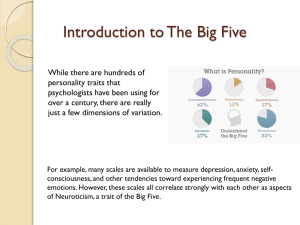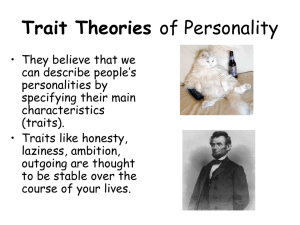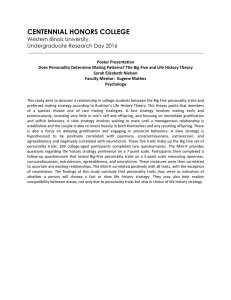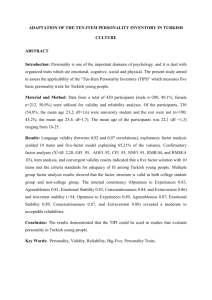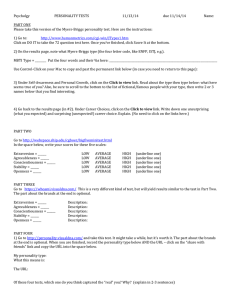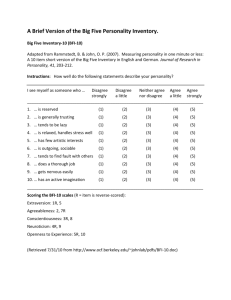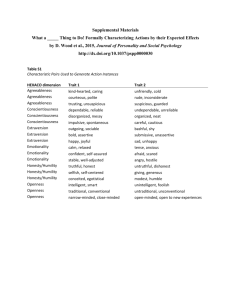Document 13116780
advertisement
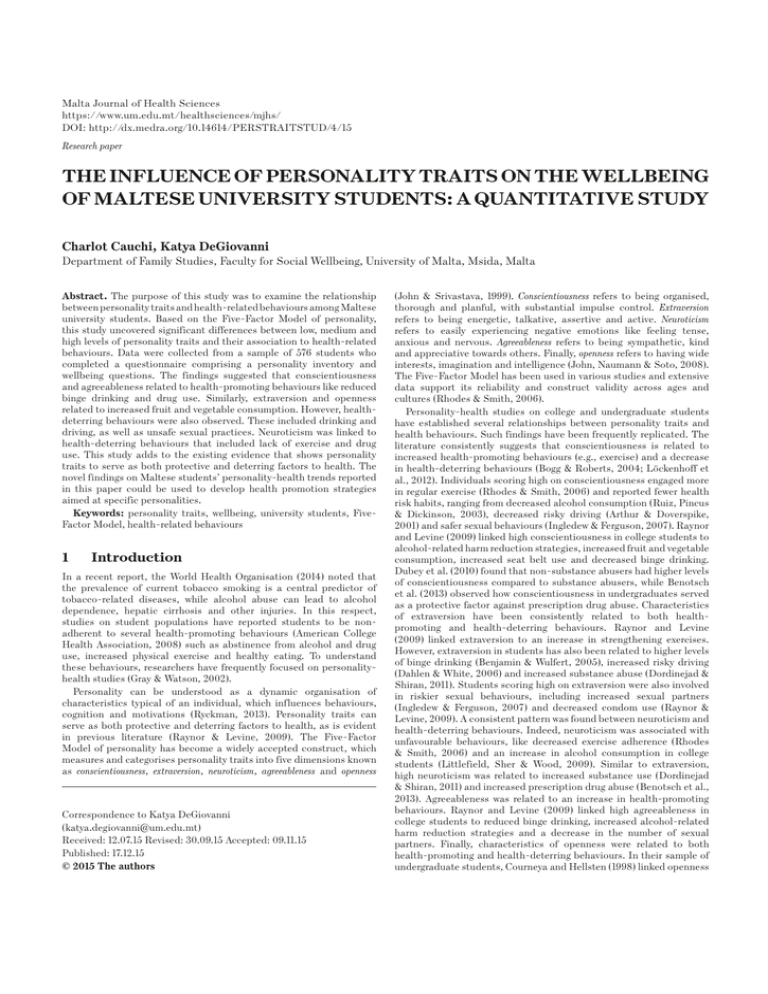
Malta Journal of Health Sciences https://www.um.edu.mt/healthsciences/mjhs/ DOI: http://dx.medra.org/10.14614/PERSTRAITSTUD/4/15 Research paper THE INFLUENCE OF PERSONALITY TRAITS ON THE WELLBEING OF MALTESE UNIVERSITY STUDENTS: A QUANTITATIVE STUDY Charlot Cauchi, Katya DeGiovanni Department of Family Studies, Faculty for Social Wellbeing, University of Malta, Msida, Malta Abstract. The purpose of this study was to examine the relationship between personality traits and health-related behaviours among Maltese university students. Based on the Five-Factor Model of personality, this study uncovered significant differences between low, medium and high levels of personality traits and their association to health-related behaviours. Data were collected from a sample of 576 students who completed a questionnaire comprising a personality inventory and wellbeing questions. The findings suggested that conscientiousness and agreeableness related to health-promoting behaviours like reduced binge drinking and drug use. Similarly, extraversion and openness related to increased fruit and vegetable consumption. However, healthdeterring behaviours were also observed. These included drinking and driving, as well as unsafe sexual practices. Neuroticism was linked to health-deterring behaviours that included lack of exercise and drug use. This study adds to the existing evidence that shows personality traits to serve as both protective and deterring factors to health. The novel findings on Maltese students’ personality-health trends reported in this paper could be used to develop health promotion strategies aimed at specific personalities. Keywords: personality traits, wellbeing, university students, FiveFactor Model, health-related behaviours 1 Introduction In a recent report, the World Health Organisation (2014) noted that the prevalence of current tobacco smoking is a central predictor of tobacco-related diseases, while alcohol abuse can lead to alcohol dependence, hepatic cirrhosis and other injuries. In this respect, studies on student populations have reported students to be nonadherent to several health-promoting behaviours (American College Health Association, 2008) such as abstinence from alcohol and drug use, increased physical exercise and healthy eating. To understand these behaviours, researchers have frequently focused on personalityhealth studies (Gray & Watson, 2002). Personality can be understood as a dynamic organisation of characteristics typical of an individual, which influences behaviours, cognition and motivations (Ryckman, 2013). Personality traits can serve as both protective and deterring factors to health, as is evident in previous literature (Raynor & Levine, 2009). The Five-Factor Model of personality has become a widely accepted construct, which measures and categorises personality traits into five dimensions known as conscientiousness, extraversion, neuroticism, agreeableness and openness Correspondence to Katya DeGiovanni (katya.degiovanni@um.edu.mt) Received: 12.07.15 Revised: 30.09.15 Accepted: 09.11.15 Published: 17.12.15 © 2015 The authors (John & Srivastava, 1999). Conscientiousness refers to being organised, thorough and planful, with substantial impulse control. Extraversion refers to being energetic, talkative, assertive and active. Neuroticism refers to easily experiencing negative emotions like feeling tense, anxious and nervous. Agreeableness refers to being sympathetic, kind and appreciative towards others. Finally, openness refers to having wide interests, imagination and intelligence (John, Naumann & Soto, 2008). The Five-Factor Model has been used in various studies and extensive data support its reliability and construct validity across ages and cultures (Rhodes & Smith, 2006). Personality-health studies on college and undergraduate students have established several relationships between personality traits and health behaviours. Such findings have been frequently replicated. The literature consistently suggests that conscientiousness is related to increased health-promoting behaviours (e.g., exercise) and a decrease in health-deterring behaviours (Bogg & Roberts, 2004; Löckenhoff et al., 2012). Individuals scoring high on conscientiousness engaged more in regular exercise (Rhodes & Smith, 2006) and reported fewer health risk habits, ranging from decreased alcohol consumption (Ruiz, Pincus & Dickinson, 2003), decreased risky driving (Arthur & Doverspike, 2001) and safer sexual behaviours (Ingledew & Ferguson, 2007). Raynor and Levine (2009) linked high conscientiousness in college students to alcohol-related harm reduction strategies, increased fruit and vegetable consumption, increased seat belt use and decreased binge drinking. Dubey et al. (2010) found that non-substance abusers had higher levels of conscientiousness compared to substance abusers, while Benotsch et al. (2013) observed how conscientiousness in undergraduates served as a protective factor against prescription drug abuse. Characteristics of extraversion have been consistently related to both healthpromoting and health-deterring behaviours. Raynor and Levine (2009) linked extraversion to an increase in strengthening exercises. However, extraversion in students has also been related to higher levels of binge drinking (Benjamin & Wulfert, 2005), increased risky driving (Dahlen & White, 2006) and increased substance abuse (Dordinejad & Shiran, 2011). Students scoring high on extraversion were also involved in riskier sexual behaviours, including increased sexual partners (Ingledew & Ferguson, 2007) and decreased condom use (Raynor & Levine, 2009). A consistent pattern was found between neuroticism and health-deterring behaviours. Indeed, neuroticism was associated with unfavourable behaviours, like decreased exercise adherence (Rhodes & Smith, 2006) and an increase in alcohol consumption in college students (Littlefield, Sher & Wood, 2009). Similar to extraversion, high neuroticism was related to increased substance use (Dordinejad & Shiran, 2011) and increased prescription drug abuse (Benotsch et al., 2013). Agreeableness was related to an increase in health-promoting behaviours. Raynor and Levine (2009) linked high agreeableness in college students to reduced binge drinking, increased alcohol-related harm reduction strategies and a decrease in the number of sexual partners. Finally, characteristics of openness were related to both health-promoting and health-deterring behaviours. In their sample of undergraduate students, Courneya and Hellsten (1998) linked openness 56 The influence of personality traits on the wellbeing of Maltese university students to increased exercise engagement, while Raynor and Levine (2009) linked openness to higher fruit and vegetable consumption. In contrast, Benotsch et al. (2013) found associations between high openness and prescription drug abuse in their undergraduate sample. Personality-health literature has been used to develop strategic interventions aimed specifically at individuals with a particular personality type. For example, Conrad, Castellanos and Mackie (2008) targeted 11- to 15-year-old adolescents scoring high on extraversion, a trait highlighted by sensation seeking, with the aim of reducing alcohol abuse. Cognitive behavioural exercises and personality psycho-education were developed to facilitate coping strategies for these individuals. The results showed that interventions reduced the likelihood of binge drinking by up to 50% for up to 12 months. These results suggest that personality-health studies could allow the development of health-promoting interventions that are designed specifically for individual personality types. Personality health has been widely researched across Europe and the United States. The current study aims to understand the link between personality traits and health-behaviour variables among Maltese students. Besides the main objective of replicating previous studies and allowing comparisons, this study serves as a basis for future personality-health research directed at other Maltese populations, such as younger students and older adult populations. It also addresses the limited personality-health research based in Malta and adds to the local health literature. 2 Methods The study adopted a quantitative approach to allow data collection from a wide population range. Quantitative research is concerned with quantifying phenomena; hence, it provides a more objective type of measure (Langdridge & Hagger-Johnson, 2009). This approach was chosen so that the results attained would enable comparisons to the existent literature. 2.1 Participants A sample of 576 Maltese university students responded from a total of 11,067, which represents a 5.2% response rate. Participants included 166 males (29%) and 410 females (71%) aged between 17 and 62 years, with a mean age of 24 years. 2.2 Research design The questionnaire used consisted of three main sections. The first section included questions about demographics. The second section comprised a personality inventory with statements that identified personality traits. Personality traits were measured using the Big Five Inventory (BFI) (John, Donahue & Kentle, 1991). This inventory consists of 44 statements which are rated on a five-point Likert scale, where 1 corresponds to ‘Strongly Disagree’ and 5 corresponds to ’Strongly Agree’. Despite being a short scale measure, the BFI presents with an average Cronbach’s alpha of .83. This is a level of reliability similar to that of other personality inventories such as the NeuroticismExtraversion-Openness-Five-Factor Inventory (NEO-FFI) (Costa and McCrae, 1992) and the Trait Descriptive Adjectives (TDA) scales (Goldberg, 1992), which have an average Cronbach’s alpha of .81 and .84 respectively. Convergent validity with other personality inventories was also substantial. The BFI showed an overall convergence of .80 with the TDA and a .77 convergence with the NEO-FFI (John et al., 2008). These characteristics motivated choice of the BFI for use in this study. The BFI was also deemed more time-efficient, hence reducing the possible lack of responses due to a lengthy questionnaire. The third section of the questionnaire included questions measuring health-behaviour variables. Health-behaviour questions were constructed with reference to a research tool by Cefai and Camilleri (2009), with some questions being amended or omitted. Health-behaviour questions were clustered into four sections, namely ‘general health habits’ (e.g., dietary habits, physical exercise), ‘alcohol use’, ‘drug use’ and ‘sexual behaviours’. Most of these questions were measured on a five-point Likert scale, where 1 corresponded to ‘Strongly Disagree’ and 5 corresponded to ‘Strongly Agree’. 2.3 Data collection and analysis The questionnaire was piloted on ten randomly selected Maltese university students to gain feedback about any ambiguities. The pilot questionnaire was then adjusted by rewording questions, adding options and including definitions for terms such as ‘junk food’ and ‘binge drinking’. The final version of the questionnaire was sent by email through the Registrar’s Office at the University of Malta, to ensure that it reached the entire student population. In turn, this ensured randomness in participant recruitment because every student received the questionnaire in the same period and had equal opportunity to respond. The data collected were coded as numeric values and analysed using the Statistical Package for the Social Sciences (SPSS) Version 20. The significance threshold was set at .05. Descriptive and inferential statistics were carried out using the one-way Analysis of Variance (ANOVA) test and the Student-Newman-Keuls post hoc test, while Cronbach’s alpha provided a measure of internal consistency between personality items. 2.4 Ethical considerations Potential participants were briefed through an information letter before they were directed to the online survey. The briefing section stated that participation was voluntary, responses were anonymous and participants could stop their survey participation at any time. All responses were treated with full confidentiality and only the authors were able to access the collected data. 3 Results In order to have representative data that allowed comparisons, personality trait scores were recoded into grouped variables. After observing the cumulative percentage in frequency tables, personality trait results were divided into three score categories: low, medium, and high. The internal consistency of the BFI was measured and results are displayed in Table 1. Cronbach’s alpha for personality traits resulted in a reliability coefficient of .73. This shows good internal consistency, meaning that the measure reflected the construct that it was measuring. Table 1. Cronbach’s alpha reliability for personality traits Personality traits Cronbach's alpha No. of items Conscientiousness .79 9 Extraversion .82 8 Agreeableness .74 9 Neuroticism .83 8 Openness .71 10 All personality variables .73 44 3.1 Conscientiousness As seen in Table 2, statistically significant differences for conscientiousness were found in four health-behaviour variables, namely healthy breakfast consumption, junk food consumption, binge drinking and cannabis use. Students who scored high on conscientiousness reported a significant increase in healthy breakfast The influence of personality traits on the wellbeing of Maltese university students consumption (mean = 2.71) in comparison to students scoring medium or low. Students scoring high on conscientiousness also reported a significant decrease in junk food consumption (mean = 3.96), binge drinking (mean = 1.60) and cannabis use (mean = 0.55) in comparison to students scoring medium or low on conscientiousness. Table 2. One-way ANOVA test for significant differences between low, medium and high scores on conscientiousness and health-behaviour variables Conscientiousness mean rating score F-statistic Degrees of freedom p-value 2, 573 .001*** 57 3.2 Extraversion Table 3 shows that statistically significant differences for extraversion were observed in six health-behaviour variables, namely fruit and vegetable consumption, junk food consumption, coffee consumption, alcohol use, drinking and driving and unintentional pregnancy. Students who scored higher on extraversion reported a significant increase in fruit and vegetable consumption (mean = 2.37) while reporting a significant decrease in junk food consumption (mean = 3.88) in comparison to students scoring lower on extraversion. Students scoring higher on extraversion also reported a significant increase in coffee consumption (mean = .89), alcohol use (mean = 1.59), drinking and driving (mean = .83), and unintentional pregnancy (mean = 2.12) when compared to students scoring lower on extraversion. ‘I have a healthy breakfast’ Low 3.35 Medium 3.11 High 2.71 7.806 ‘I consume junk food’ Low 3.62 Medium 3.95 High 3.96 Low 2.48 5.703 2, 573 .004** 2, 573 .001*** ‘I engage in binge drinking’ Medium 1.79 High 1.60 27.023 ‘When was the last time you ever used or took any of the following? Cannabis’ Low 3.3 Agreeableness As reported in Table 4, statistically significant differences for agreeableness were found in six health-behaviour variables, namely junk food consumption, binge drinking, cannabis use, ecstasy use, cocaine use and inhalant use. Students who scored higher on agreeableness reported a significant decrease in junk food consumption (mean = 3.95) and binge drinking (mean = 1.79) in comparison to students scoring lower on agreeableness. Similarly, students scoring higher on agreeableness reported a significant decrease in recent cannabis use (mean = .58), ecstasy use (mean = .08), cocaine use (mean = .09) and inhalant use (mean = .03) in comparison to students scoring lower on agreeableness. .90 Medium .76 High .55 3.145 2, 573 .044* Note. Conscientiousness score refers to low (10-28), medium (29-33) and high (34-45); *p < .05, **p < .01, ***p < .001 Table 4. One-way ANOVA test for significant differences between low, medium and high Scores on agreeableness and health-behaviour variables Agreeableness mean rating score F-statistic Degrees of freedom p-value ‘I consume junk food’ Low Table 3. One-way ANOVA test for significant differences between low, medium and high scores on extraversion and health-behaviour variables Extraversion mean rating score F-statistic Degrees of freedom p-value ‘How many servings of fruits and vegetables do you consume daily?’ Low 1.98 Medium 2.57 High 2.37 Low 3.64 Medium 4.08 High 3.88 Low .63 Medium .71 High .89 2,573 .004** 1.65 High 1.59 7.469 2,573 .001** .70 Medium 1.07 High .83 2.23 Medium 2.09 High 2.12 1.78 High 1.79 5.134 4.498 3.815 8.586 2,573 .001*** 1.00 Medium .66 High .58 4.937 2,573 .007** 2,573 2,513 2,513 2,320 .38 Medium .12 High .08 .006** 8.603 2,573 .001*** .038* .29 Medium .18 High .09 3.243 2,573 .04* ‘When was the last time you ever used or took any of the following? Inhalants’ Low 3.282 .028* ‘When was the last time you ever used or took any of the following? Cocaine’ .25 Medium .14 High .03 4.659 2,573 .01* Note. Agreeableness score refers to low (19-31), medium (32-35) and high (36-44); *p < .05, **p < .01, ***p < .001 .012* ‘In the last year, have you unintentionally become or gotten someone pregnant?’ Low Medium 2,573 ‘I engage in binge drinking’ Low ‘In the last month, did you drive after having five or more drinks?’ Low 2.26 3.584 ‘When was the last time you ever used or took any of the following? Ecstasy’ ‘In the last month, how many alcoholic drinks did you have on average at social events?’ Medium Low Low ‘Average daily caffeine intake – cup/s of coffee’ 1.40 3.95 ‘When was the last time you ever used or took any of the following? Cannabis’ ‘I consume junk food’ Low 3.91 High Low 5.687 3.67 Medium .023* Note. Extraversion score refers to low (9-22), medium (23-26) and high (27-40); *p < .05, **p < .001 3.4 Neuroticism Table 5 shows that statistically significant differences for neuroticism were observed in two health-behaviour variables: healthy breakfast consumption and ecstasy use. Students who scored high on neuroticism reported a significant decrease in healthy breakfast consumption 58 The influence of personality traits on the wellbeing of Maltese university students (mean = 3.34) in comparison to students scoring medium or low on neuroticism. Students scoring higher on neuroticism also reported a significant increase in ecstasy use (mean = 0.24) in comparison to students scoring lower on neuroticism. Table 5. One-way ANOVA Test for significant differences between low, medium and high scores on neuroticism and health-behaviour variables Neuroticism mean rating score F-statistic Degrees of freedom p-value 2,573 .005** ‘I have a healthy breakfast’ Low 2.80 Medium 3.03 High 3.34 5.328 ‘When was the last time you ever used or took any of the following? Ecstasy’ Low .05 Medium .26 High .24 4.574 2, 573 .011* Note. Neuroticism score refers to low (9-23), medium (24-28) and high (29-40); *p < .05, **p < .01. 3.5 Openness As seen in Table 6, statistically significant differences for openness were found in two health-behaviour variables: fruit and vegetable consumption and sexual partners. Students who scored high on openness reported a significant increase in fruit and vegetable consumption (mean = 2.66) in comparison to students scoring medium or low in openness. Students scoring high on openness also reported a significant increase in the number of sexual partners (mean = 1.41) in comparison to students scoring medium or low on openness. 4.1 Health-promoting traits High conscientiousness scores underlined a significant increase in healthy breakfast consumption and, simultaneously, a significant decrease in junk food consumption. This result emphasises how selfdiscipline in conscientious individuals not only promotes healthier practices, but also reduces health-deterring lifestyles. Moreover, conscientiousness seems to protect against health-deterring behaviours as results suggest a significant decrease in alcohol use. In contrast, students scoring low on conscientiousness were significantly more likely to report drinking excessively. This finding is similar to that reported in an earlier study by Ruiz et al. (2003) and shows that conscientious individuals may be more self-controlling and, hence, better able at regulating alcohol consumption. Raynor and Levine (2009) found that binge drinking was reported significantly higher in lower conscientiousness students. An explanation for this could be that conscientious individuals are perhaps better able at controlling impulses, thus reducing the likelihood of binge drinking. Cannabis use was linked significantly less with students scoring higher on levels of conscientiousness. Hallucinogen use was reported significantly less by high conscientiousness students when compared to medium conscientiousness, although low conscientiousness in students did not result in increased hallucinogen use. This replicates a finding by Dubey et al. (2010) that showed lower conscientiousness scores to be more associated with drug users than non-drug users. Results for high agreeableness showed a significant decrease in junk food consumption. Furthermore, agreeableness also highlighted a significant decrease in binge drinking, which complements earlier studies (Raynor & Levine, 2009; Ruiz et al., 2003). Results for agreeableness were also linked to a significant decrease in drug use, including cannabis, ecstasy, cocaine and inhalants. These results suggest that high agreeableness students are perhaps more concerned about the welfare of others. Hence, they are less likely to engage in risky behaviours that negatively influence others. 4.2 Health-promoting and health-deterring traits Table 6. One-way ANOVA test for significant differences between low, medium and high scores on openness and health-behaviour variables Openness mean rating score F-statistic Degrees of freedom p-value ‘On average, how many servings of fruits and vegetables do you consume daily?’ Low 1.98 Medium 2.23 High 2.66 8.035 2,573 .001** ‘How many sexual partners did you have within the last academic year?’ Low 1.17 Medium 1.34 High 1.41 3.252 2, 333 .04* Note. Openness score refers to low (19-33), medium (34-37) and high (38-50); *p < .05, **p < .001 4 Discussion The aim of this study was to understand the link between personality trait scores and health-behaviour variables in undergraduate students. The results showed that significant differences were observed between different personality trait scores and both health-promoting and health-deterring behaviours. Results are discussed under three subsections. The first section discusses the results for conscientiousness and agreeableness, which were primarily linked to health-promoting behaviours. The second part discusses how results for extraversion and openness were linked to both health-promoting and healthdeterring behaviours. The final section discusses neuroticism, which was exclusively linked to health-deterring behaviours. High extraversion scores were linked to a significant increase in fruit and vegetable consumption. Simultaneously, students reported a significant decrease in junk food consumption. This suggests the adoption of a healthier lifestyle by such individuals. Extraversion was also linked to a significant increase in coffee consumption, which highlights the facet of stimulation seeking. Indeed, extraverted students perhaps consume coffee more regularly since the caffeine acts as a stimulant, complementing their energetic personality. On the other hand, students scoring low on extraversion reported a significant decrease in drinking at social events compared to medium extraversion, although high extraversion did not underline a significant increase in alcohol use. This result replicates previous findings in which increased extraversion was linked to higher alcohol consumption and binge drinking (Benjamin & Wulfert, 2005). Furthermore, students scoring low on extraversion showed a significant reduction in drinking and driving behaviours compared to medium extraversion, although high extraversion students did not relate to increased drinking and driving behaviours. This complements earlier studies in which higher extraversion was related to an increase in risky driving (Dahlen & White, 2006). Notably, low extraversion seems to act as a protective factor against alcohol use. However, it is medium extraversion that increased alcohol use, rather than high extraversion. This suggests that the relationship between extraversion levels and alcohol use is complex. Nevertheless, these results underline how extraverted individuals somehow seek stimulating opportunities. Facets of extraversion, like being outgoing and enjoying the company of others, may contribute to an increased likelihood of engaging in excessive drinking. In contrast to conscientiousness, extraversion does not seem to protect against health-deterring behaviours. Unintentional pregnancy was reported significantly more in persons with higher extraversion scores. This corroborates previous studies in which extraversion was linked to The influence of personality traits on the wellbeing of Maltese university students increased numbers of sexual partners (Ingledew & Ferguson, 2007) and decreased condom use (Raynor & Levine, 2009). Certainly, the combined facets of sociability and sensation seeking may explain why extraverted individuals are more likely to engage in risky behaviours, including unprotected sex. Students with high openness scores reported a significant increase in fruit and vegetable consumption, replicating a finding of an earlier study by Raynor and Levine (2009). This result suggests that students with high openness perhaps have a greater willingness to consider new ideas, such as adhering to a healthier lifestyle. Conversely, openness was also linked to a significant increase in sexual partners. This highlights other characteristics of openness, including unconventionality and curiosity, which perhaps explains why these individuals engaged in risky behaviours. Compared to the other personality traits, scores for openness produced only a few significant results with health-behaviour variables. This lack of significant findings for the openness trait is similarly observed in other personality-health studies (e.g., Raynor & Levine, 2009), which suggests that openness may play a minimal role in understanding health behaviours. while neuroticism was associated with a significant increase in ecstasy use. Health-deterring behaviours such as drinking and driving, and unintentional pregnancy were mainly linked to extraversion, although openness showed similar results with an increase in the number of sexual partners. 6 Compared to all other personality traits, neuroticism was the only trait that showed a significant increase in most health-deterring behaviours. Students scoring high on neuroticism reported a significant decrease in healthy breakfast consumption, as well as a significant increase in ecstasy use, corroborating earlier research findings (Dordinejad & Shiran, 2011; Dubey et al., 2010). Indeed, the increase in drug use by such individuals may reflect a greater vulnerability to stress. This characteristic possibly explains why individuals with high neuroticism easily experience negative emotions like sadness and fear and hence, are more likely to use substances to deal with unpleasant situations. 4.4 Limitations Acknowledgements The authors would like to thank all university students who anonymously took part in this research study. 7 Funding This research has received no specific grant from any funding agency in the public, commercial or non-profit sectors. 8 4.3 Health-deterring traits 59 Conflicts of interest The authors report no conflicts of interest. References American College Health Association (2008) National College Health Assessment Spring 2007 reference group data report (abridged). Journal of American College Health, 56(5), pp. 469–479. Arthur, W. J. & Doverspike, D. (2001) Predicting motor vehicle crash involvement from a personality measure and a driving knowledge test. Journal of Prevention and Intervention in the Community, 22(1), pp. 35–42. Benjamin, L. & Wulfert, E. (2005) Dispositional correlates of addictive behaviors in college women: binge eating and heavy drinking. Eating Behaviors, 6(3), pp. 197–209. The main limitation of this study was the cross-sectional design in data collection. Although this allowed significant differences to be detected between groups, the results could not be used for inferring how personality traits could be directly causing variations in health behaviours. Another limitation was the lack of representation of the student population, which resulted in a lack of generalisability. Indeed, the sample was relatively homogenous, with participants being primarily females and under 20 years. Furthermore, health-behaviour responses were elicited through self-reported measures which could lead individuals to over- or under-report their behaviours. Finally, data were collected entirely through online questionnaire responses. Although the questionnaire was easily accessible, inexpensive and reached a large number of participants, the lack of personal contact may have led to participants not being entirely truthful in their responses. This highlights the need to be critical when interpreting online responses, due to validity issues. Bogg, T. & Roberts, B. W. (2004) Conscientiousness and health-related behaviors: a meta-analysis of the leading behavioral contributors to mortality. Psychological Bulletin, 130(6), pp. 887–919. doi: 10.1037/0033-2909-130.6.887. 5 Costa, P. T. & McCrae, R. R. (1992) NEO PI-R Professional Manual. Odessa, FL: Psychological Assessment Resources. Conclusion This study has introduced personality-health studies within the Maltese context, with the results obtained extending the well-established body of personality-health literature. Findings suggest that patterns observed between personality and health-behaviour variables were rather similar to those identified in previous studies. Students scoring high in conscientiousness and agreeableness showed a significant increase in health-promoting behaviours, whereas neuroticism scores were linked to health-deterring behaviours. High scores in extraversion and openness highlighted both health-promoting and health-deterring behaviours. In general, conscientiousness and agreeableness served as protective traits against alcohol use, whereas extraversion highlighted a significant increase in alcohol use. Moreover, agreeableness and conscientiousness also served as protective traits against drug use, Benotsch, E. G., Jeffers, A. J., Snipes, D. J., Martin, A. M. & Koester, S. (2013) The five factor model of personality and the non-medical use of prescription drugs: associations in a young adult sample. Personality and Individual Differences, 55(7), pp. 852–855. Cefai, C. & Camilleri, L. (2009) Healthy Students Healthy Lives: The health of Maltese university students. Msida: University of Malta. Conrad, P. J., Castellanos, N. & Mackie, C. (2008) Personality-targeted interventions delay the growth of adolescent drinking and binge drinking. Journal of Child Psychology and Psychiatry, 49(2), pp. 181190. Courneya, K. S. & Hellsten, L. M. (1998) Personality correlates of exercise behavior, motives, barriers and preferences: an application of the five-factor model. Personality and Individual Differences, 24(5), pp. 625–633. Dahlen, E. R. & White, R. P. (2006) The Big Five factors, sensation seeking, and driving anger in the prediction of unsafe driving. Personality and Individual Differences, 41(5), pp. 903–915. Dordinejad, F. G. & Shiran, M. A. G. (2011) Personality traits and drug usage among addicts. Literacy Information and Computer Education Journal, 2(2), pp. 402-405. Dubey, C., Arora, M., Gupta, S. & Kumar, B. (2010) Five factor correlates: a comparison of substance abusers and non-substance abusers. 60 The influence of personality traits on the wellbeing of Maltese university students Journal of the Indian Academy of Applied Psychology, 36(1), pp. 107114. Goldberg, L. R. (1992) The development of markers for the Big-Five factor structure. Psychological Assessment, 4(1), pp. 26-42. Gray, E. K. & Watson, D. (2002) General and specific traits of personality and their relation to sleep and academic performance. Journal of Personality, 70(2), pp. 177–206. Ingledew, D. K. & Ferguson, E. (2007) Personality and riskier sexual behaviour: motivational mediators. Psychology and Health, 22(3), pp. 291–315. John, O. P., Donahue, E. M. & Kentle, R. L. (1991) The Big Five Inventory – Versions 4a and 54. Berkeley, CA: University of California, Berkeley, Institute of Personality and Social Research. John, O. P., Naumann, L. P. & Soto, C. J. (2008) Paradigm shift to the integrative Big-Five trait taxonomy: history, measurement, and conceptual issues. In O. P. John, R. W. Robins & L. A. Pervin (Eds) Handbook of Personality: Theory and research (pp. 114-158). New York, NY: The Guilford Press. John, O. P. & Srivastava, S. (1999) The Big Five: history, measurement, and development. In L. A. Pervin, & O. P. John (Eds) Handbook of Personality: Theory and research (pp. 102–138). New York, NY: Guilford Press. Langdridge, D. & Hagger-Johnson, G. (2009) Introduction to Research Methods and Data Analysis in Psychology (2nd ed.). Harlow: Pearson Education. Littlefield, A., Sher, K. J. & Wood, P. K. (2009) Is ‘maturing out’ of problematic alcohol involvement related to personality change? Journal of Abnormal Psychology, 118(2), pp. 360−374. Löckenhoff, C. E., Terracciano, A., Ferrucci, L. & Costa, P. T. J. (2012) Five-factor personality traits and age trajectories of self-rated health: the role of question framing. Journal of Personality, 80(2), pp. 375-401. doi:10.1111/j.1467-6494.2011.00724.x. Raynor, D. A. & Levine, H. (2009) Associations between the fivefactor model of personality and health behaviors among college students. Journal of American College Health, 58(1), pp. 73-82. doi: 10.3200/JACH.58.1.73-82. Rhodes, R. E. & Smith, N. E. (2006) Personality correlates of physical activity: a review and meta-analysis. British Journal of Sports Medicine, 40(12), pp. 958–965. Ruiz, M. A., Pincus, A. L. & Dickinson, K. A. (2003) NEO PI-R predictors of alcohol use and alcohol-related problems. Journal of Personality Assessment, 81(3), pp. 226–236. Ryckman, R. M. (2013) Theories of Personality (10th ed.). Belmont, CA: Wadsworth Publishing. World Health Organisation (2014) World Health Statistics 2014. Geneva: World Health Organisation.
